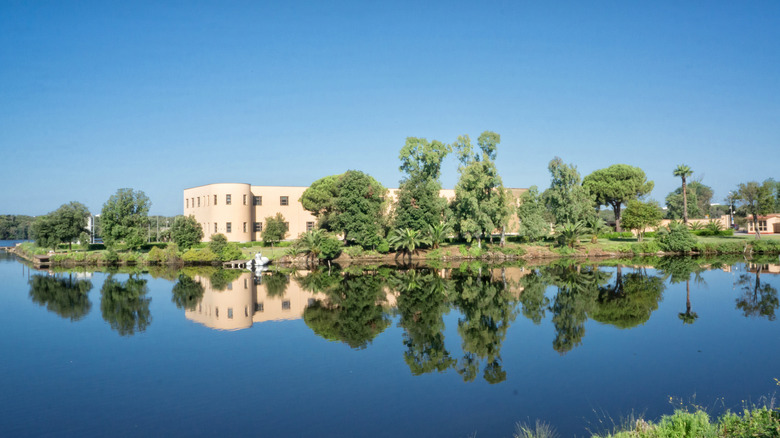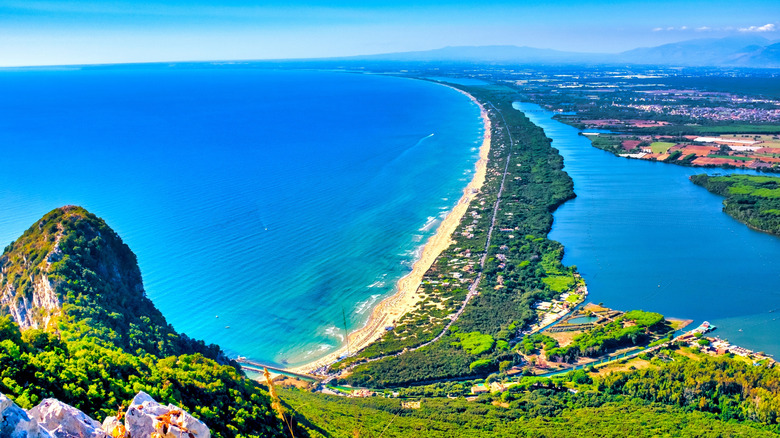Sandwiched Between Rome And Naples Is A Quiet Coastal Town In Italy With A National Park Backdrop
Travelers in Italy often stop in its major cities, from Southern Italy's Naples, with its impressive history lying underground, to Northern Italy's Florence, called Europe's "cultural capital" by Rick Steves. But if you're just zipping from one metropolis to another, you might overlook what lies in between. Take a detour to the coast south of Rome, and you'll find a town where the rigid hand of modernism has been softened by time and nature. Sabaudia is a bit different from what travelers come to expect from an Italian getaway. Unlike the medieval hilltop towns and ancient ruins you'll find elsewhere in the country, Sabaudia was shaped by the turbulent era of Italy's fascist regime, known for its minimalist, stark architecture.
Sabaudia is about an hour and a half from Rome, by train or car, and closer to three hours from Naples, making it a great stop if you're traveling between the two cities or just want a unique coastal escape. The closest major airport for flying into Sabaudia is the Rome-Fiumicino International Airport. With its clean lines and grid-like layout rising up alongside pine forests and glassy lagoons, Sabaudia is a somewhat strange sight when you come upon it. But its appeal lies in this contrast between its fraught history and the calm, coastal retreat it is today. Here, you'll find long stretches of beach, boardwalks through pine groves, and the Circeo National Park, which surrounds the town.
Sabaudia, the seaside town that was built in less than a year
Sabaudia was built in 1934 during Mussolini's fascist regime — in no more than 253 days. The town's establishment was part of an effort of the regime to reclaim the Pontine Marshes (an agricultural area of South-Central Italy), which also led to the creation of Circeo National Park. They city's geometric architecture reflects the rationalist ideology of the regime and serves as an interesting entryway for learning about this turbulent period of Italian history, which also produced such structures as Palazzo della Civiltà Italiana, Rome's "square colosseum." One of the most striking fascist-era structures in Sabaudia is the post office, painted with bold Mediterranean colors along its clean lines.
As a visitor to Sabaudia, it might feel odd to find yourself touring and even admiring designs tied to dictatorship and an aggressive military power. On one hand, it's important to recognize the history and damage the buildings symbolize, which, if viewed uncritically, end up "hiding the dictatorship, the persecutions, the discriminations and the war," as historian Lucia Ceci told NPR. On the other hand, Ceci also doesn't think fascist buildings should be destroyed. Instead, she believes they should be contextualized as historical reminders, rather than erased altogether. Reading up a bit on Italy's rationalist architecture and Mussolini's tactics helps frame what you're seeing, but it also leaves you with more to take away from your trip. Aside from the post office, the Church of the Annunciation and the Town Hall, with its minimalist tower, are a couple more examples of this design worth seeing.
Sabaudia's beaches, lagoons, and dunes
Today, Sabaudia is a peaceful beach town within Circeo National Park. How Sabaudia has evolved, and how its past remains visible among the natural beauty, adds another meaningful dimension to your trip. You won't find big resorts here; instead, Sabaudia's shores are characterized by long, crowd-free beaches, sand dunes, and lagoons. Many of the beaches are part of small beach clubs. One great beach club option is Saporetti, which is surrounded by villas and has two bars. Another good choice is Lilandà, which stands out for its views of the sand dunes.
The Circeo National Park, which extends around Sabaudia itself, frames the town in lagoons, trails, and Mount Circeo. Its most well-known lagoon is Sabaudia Lake, a popular spot for lakeside vacation rentals and for watersports. The area around Sabaudia Lake is known for its rich wildlife, serving as a habitat for wild boars, flamingos, and peregrine falcons, to name a few. You'll find lots of breathtaking hiking trails around Mount Circeo, including a roughly five-hour hike that treks across the mountain from Sabaudia to San Felice Circeo. Around the slopes of the mountain, be sure to check out some of its caves, including the prehistoric Guattari Cave, which can be seen on a tour.


